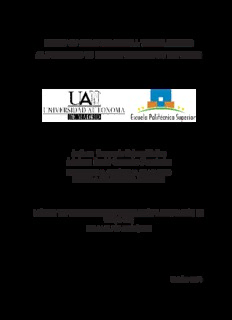
Fernando Palero Molina Advisor: David Camach PDF
Preview Fernando Palero Molina Advisor: David Camach
STUDY OF COMPUTATIONAL INTELLIGENCE ALGORITHMS TO DETECT BEHAVIOUR PATTERNS Author: Fernando Palero Molina Advisor: David Camacho Fernández UNIVERSIDAD AUTÓNOMA DE MADRID ESCUELA POLITÉCNICA SUPERIOR MÁSTER UNIVERSITARIO EN INVESTIGACIÓN E INNOVACIÓN EN TIC (i2-TIC) TRABAJO FIN DE MÁSTER October 2014 Pararecorrerconéxitoelcamino,unamenteabiertaeslaclave. GRACIASporestecamino. Por quedeélaprendí: gratitudy humildad. Locual, medejaverquelonatural eshermoso, honestoy brutal. GRACIAS! Acknowledgements ThisworkhasbeensupportedbyAirbusDefence&Space(SavierProject: FUAM-076914), and partially by the Spanish Ministry of Science and Education under the Project Code TIN2010-19872. I would like to express my grateful to the Savier project team specially I wouldliketomentiontoJoséInsenser,Juan AntonioHenriquezand GemmaBlasco. Abstract 1 In order to achieve the game flow and increase player retention, it is important that games difficulty matches player skills. As a consequence, to evaluate how people play a game is a crucial component, because detecting gamers strategies in video-games, it is possible to fix the game difficulty. The main problem to detect the strategies is whether attributes selected to define the strategies correctly detect the actions of the player. To study the player strategies, we will use a Real Time Stategy (RTS) game. In a RTS the players make useofunitsand structures to secureareas ofamap and/ordestroy theopponentsresources. In this work, we will extract the real-time information about the players strategies using a platform base on the RTS game. After gathering information, the attributes that define the player strategies are evaluated using unsupervised learning algorithm (K-Means and Spectral Clustering). Finally, we will study the similitudeamong several gameplays where players usedifferentstrategies. 1ThisworkhasbeenfundedbyAirbusDefence&Space(SavierProject: FUAM-076914),andpartially byTIN2010-19872. Resumen2 Afindelograrqueelflujodeljuegomejoreylacaptacióndejugadoresaumente,esimpor- tantequeladificultaddeljuegoseajustealashabilidadesdeljugador. Comoconsecuencia, evaluar como juega la gente un juego es un aspecto importante, porque detectando las es- trategias de los jugadores en los vídeo juegos, permite adapta la dificultad del juego. El problemaprincipalparadetectarlasestrategiasessilosatributosseleccionadosparadefinir las estrategias definen correctamente las acciones del jugador. Para estudiar las estrategias delosjugadores,usaremosunjuegodeestrategiaentiemporeal(ReatTimeStrategy(RTS) eninglés). EnunRTSlosjugadoreshacenusodeunidadesyestructurasparaaseguraráreas del mapa y/o destruir los recursos de los oponentes. En este trabajo, extraeremos infor- mación en tiempo real acerca de las estrategias usando una plataforma basada en un juego de RTS. Después de recoger la información, los atributos que definen las estrategias de los jugadores son evaluados mediante algoritmos de aprendizaje no supervisado (K-Means y Spectral Clustering). Finalmente, estudiaremos la similitud entre diversas partidas donde los jugadoresutilizardiferentes estrategias. 2Este trabajo ha sido financiadoporAirbus Defence & Space (ProyectoSavier: FUAM-076914)y par- cialmenteporTIN2010-19872.
Description: